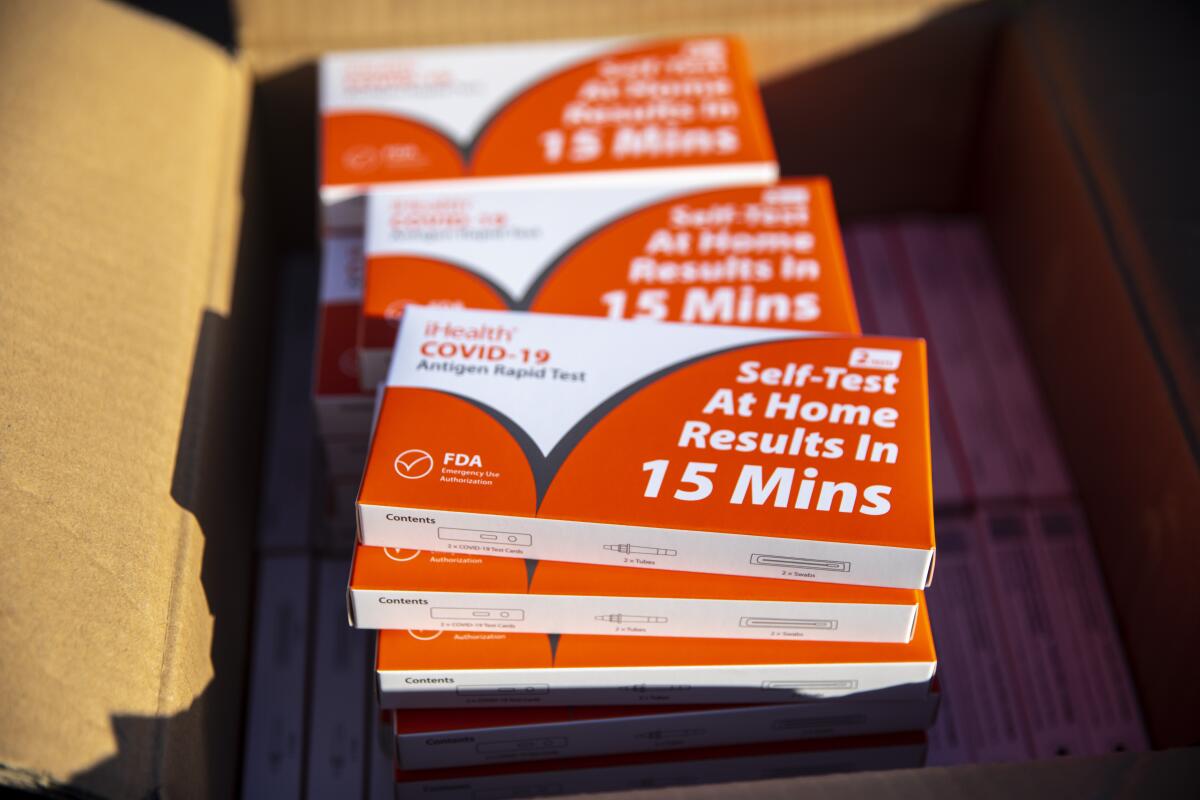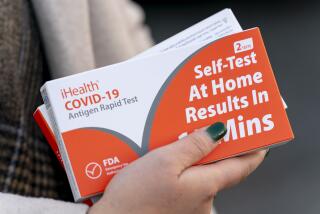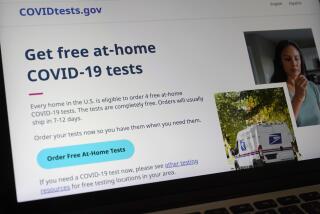5 things to know about ordering free COVID tests

- Share via
Washington — The federal website to order free rapid coronavirus tests went live on Tuesday, ahead of its scheduled Wednesday launch.
Covidtests.gov is an attempt by the Biden administration to remedy nationwide shortages of such at-home tests, with the president pledging the government will provide millions of such kits to Americans for free in coming months.
Here’s what you need to know about ordering at-home COVID-19 tests through the federal government’s website:
1. The process is simple
The first thing to know: The website is already taking orders. White House press secretary Jen Psaki said on Tuesday that the website was in “beta testing” and operating at a “limited capacity” ahead of its official launch on Wednesday. She added that the administration was anticipating having to address a “bug or two.”
I visited the site this morning — before Psaki confirmed it was taking orders — and was able to request free tests. I even received an email confirmation of my order.
All I did was visit https://www.covidtests.gov/, type in my name, email address and shipping address. I am scheduled to receive four rapid at-home COVID-19 antigen tests. You can opt to provide your email address to receive shipping updates. An order confirmation will also be sent to this email address.
The website will not process more than one order for the same address. If you try doing that, you will get this notification: “At-home COVID-19 tests have already been ordered for this address. Our records show that at-home COVID-19 tests have already been ordered for this address. We are unable to process duplicate orders for the same address.”
My order confirmation:

2. Think a few weeks down the road
President Biden announced last month that his administration will push to deliver 500 million at-home tests amid criticism over his pandemic response and strained testing availability. Last week, he said that the administration will double the number to 1 billion tests. The administration has said the first batch of those orders will begin shipping late this month.
The federal government website limits each household to four tests, and there will be a wait to get them. Officials said tests will usually ship via the U.S. Postal Service within seven to 12 days.
Lindsey Dawson, associate director of the Kaiser Family Foundation, said people should think about whether they will need the tests in coming weeks and months.
“If you’re going to school, if you’re engaging with people outside your household, if you’re using public transportation—there’s a whole range of ways that people might be at risk for contracting COVID, so it makes sense to have some at home,” Dawson said in an interview.
3. Don’t take the tests for kicks
The Centers for Disease Control recommends using an at-home test if you have a fever, sore throat, runny nose, or loss of taste or smell.
The agency also recommends people take a test at least five days within having come into contact with someone with COVID-19 and before gathering with a group of people, especially those at risk for getting seriously sick.
4. Private insurances are required to reimburse for at-home tests, too
Four tests per address will not meet everyone’s needs.
If a household requires more tests, people can buy them and get reimbursed by their private insurance carriers. Private insurance carriers are required to to reimburse the cost of up to eight tests per month.
5. Frequent testing does not replace other COVID-19 precautions
Dawson said testing is not enough to prevent COVID-19 from spreading. Such at-home tests “should be used in conjunction with other risk reduction strategies,” including getting vaccinated and wearing masks in crowded or public settings, Dawson said.
Biden is expected to announce a plan this week to make high-quality face masks available for free. Public health experts have repeatedly warned that cloth masks do not provide enough protection against the more contagious Omicron variant, recommending that people wear N95 or KN95 masks.
More to Read
Get the L.A. Times Politics newsletter
Deeply reported insights into legislation, politics and policy from Sacramento, Washington and beyond. In your inbox three times per week.
You may occasionally receive promotional content from the Los Angeles Times.











